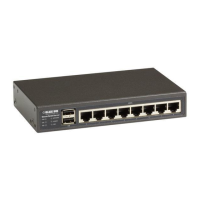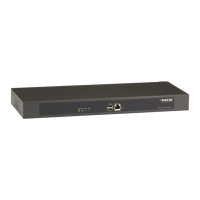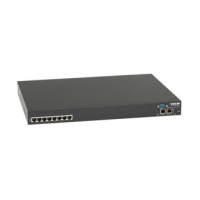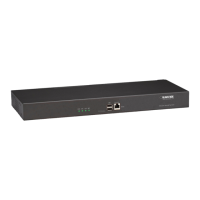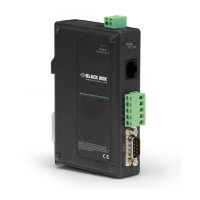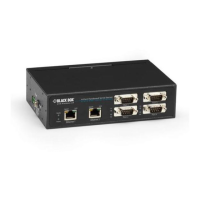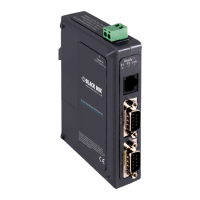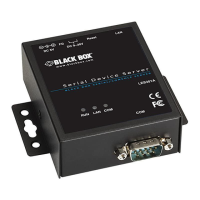Do you have a question about the Black Box LES1608A and is the answer not in the manual?
Provides detailed technical specifications for the LES1500 series console servers.
Continues the technical specifications for the LES1500 series console servers.
Provides detailed technical specifications for the LES1600 series console servers.
Continues the technical specifications for the LES1600 series console servers.
Provides detailed technical specifications for the LES1700 series console servers.
Continues the technical specifications for the LES1700 series console servers.
Describes how to connect the console server to a power source.
Explains how to connect the console server to a network.
Details how to connect serial ports to managed devices.
Details the default IP address and connection requirements for the Management Console.
Guides on setting up the connected PC's IP address for console server configuration.
Instructions for connecting to the console server using a web browser.
Covers initial administrator setup tasks, including password changes.
Details the process of changing the default root system password for security.
Guides on creating a new administrator user for ongoing management.
Details how to configure the principal Ethernet port's IP address or enable DHCP.
Explains how to enable and configure various services for access.
Introduces SDT Connector for secure server access and device management.
Explains configuring additional network ports for management or failover.
Guides on enabling the second Ethernet port as a management LAN gateway.
Details how to enable and configure the console server's DHCP server for the management LAN.
Explains how to enable and configure failover for alternate access paths.
Explains how to provision devices using DHCP during initial boot.
Details how to set common settings and operating modes for serial ports.
Explains common settings for serial ports like baud rate, parity, and data bits.
Configures a serial port for remote management access as a console server.
Details using SSH for secure console server access and managing port connections.
Describes how to set up, edit, and delete users and define access permissions.
Guides on setting up new groups and classifying users within those groups.
Details the process for setting up new user accounts and classifying them into groups.
Details automatic generation and upload of SSH keys for master/slave console server communication.
Details configuring IPsec VPN for secure access to console servers and managed devices.
Guides on enabling the VPN gateway by configuring IPsec tunnels.
Explains OpenVPN for secure tunneling and remote administration.
Guides on enabling OpenVPN by adding tunnels and selecting authentication methods.
Details configuring OpenVPN tunnels as either a server or a client.
Describes PPTP VPN for secure remote connections, typically for Windows clients.
Guides on enabling and configuring the PPTP VPN server with authentication and encryption.
Explains how IP Passthrough makes a modem connection appear as an Ethernet connection.
Details configuring a dial-out PPP connection for automatic failover during network disruptions.
Describes configuring the second Ethernet port for failover to ensure high availability.
Explains configuring cellular failover for automatic connection during network disruptions.
Explains console server support for routing, NAT, packet filtering, and port forwarding.
Details configuring network forwarding and IP masquerading for gateway functionality.
Explains how to set up port forwards to allow external users to connect to specific ports.
Details how to set up firewall rules to block or allow traffic based on various criteria.
Guides on setting up the console server for SSH tunneled access to network-attached hosts.
Details the configuration of the SDT Connector client software.
Guides on creating a secure SSH tunnel to a new console server gateway in SDT Connector.
Details making an SDT connection through the gateway to a network-attached host.
Details using SDT Connector to access devices attached to console server serial ports.
Guides on setting up SDT for secure Remote Desktop connections to Windows computers.
Guides on configuring the Remote Desktop Connection client for accessing Windows computers.
Details setting up a secure VNC connection using SDT SSH tunneling.
Explains using SDT to IP connect to hosts attached via serial ports.
Guides on setting up SDT Connector for SSH port forwarding over the console port.
Details specific settings for Auto-Response, including timeouts and disabling schedules.
Explains how to configure conditions that trigger Auto-Response actions.
Details how to configure the sequence of actions to be taken when a trigger condition is met.
Guides on configuring SMTP, SMS, SNMP, and Nagios services for remote alerts.
Explains managing Remote Power Control devices like PDUs and IPMI.
Explains configuring locally and remotely connected UPS hardware using Network UPS Tools.
Details performing remote AAA authentication using LDAP, RADIUS, Kerberos, TACACS+.
Guides on generating and installing a unique SSL certificate for secure browser access.
Details enabling Nagios on the console server and entering server addresses.
Explains how to perform soft and hard resets on the console server.
Guides on upgrading the console server's firmware.
Recommends backing up the console server configuration before significant changes or upgrades.
Guides on displaying and managing serial, network, and power connections for devices.
Explains communicating with the console server command line via SDT Connector.
Enables users to manage power outlets on connected PDUs.
Guides on accessing the console server configuration using the Linux command line and `config` utility.
Explains setting serial port modes like Console Server, Device, SDT, Terminal, Serial Bridge.
Enables SDT mode for SSH access to hosts connected to serial ports.
Details adding and removing users from the console server using command-line.
Explains changing the console server's authentication type using command-line.
Details determining and adding network hosts via command-line.
Details configuring management LAN, bridging, IPv6, and failover via CLI.
Guides on enabling and configuring the DHCP server on the management LAN via CLI.
Explains that the console server supports GNU bash shell commands for running custom scripts.
Explains how specific scripts are called when an alert is triggered.
Details using the ping-detect script to power cycle devices when ping requests fail.
Guides on backing up and restoring configuration using a local USB stick.
Explains using iptables for a stateful firewall of LAN traffic.
Covers generating and configuring SSH keys for public key authentication.
Guides on using SSH key pair authentication with SDT Connector for console server access.
Explains configuring remote power-control devices (RPCs) using Management Console and tools.
Details the ipmitool utility for managing and configuring Intelligent Platform Management Interface (IPMI) devices.
Explains Zero Touch Provisioning (ZTP) for appliance provisioning via DHCP during initial boot.
Provides detailed technical specifications for the LES1500 series console servers.
Continues the technical specifications for the LES1500 series console servers.
Provides detailed technical specifications for the LES1600 series console servers.
Continues the technical specifications for the LES1600 series console servers.
Provides detailed technical specifications for the LES1700 series console servers.
Continues the technical specifications for the LES1700 series console servers.
Describes how to connect the console server to a power source.
Explains how to connect the console server to a network.
Details how to connect serial ports to managed devices.
Details the default IP address and connection requirements for the Management Console.
Guides on setting up the connected PC's IP address for console server configuration.
Instructions for connecting to the console server using a web browser.
Covers initial administrator setup tasks, including password changes.
Details the process of changing the default root system password for security.
Guides on creating a new administrator user for ongoing management.
Details how to configure the principal Ethernet port's IP address or enable DHCP.
Explains how to enable and configure various services for access.
Introduces SDT Connector for secure server access and device management.
Explains configuring additional network ports for management or failover.
Guides on enabling the second Ethernet port as a management LAN gateway.
Details how to enable and configure the console server's DHCP server for the management LAN.
Explains how to enable and configure failover for alternate access paths.
Explains how to provision devices using DHCP during initial boot.
Details how to set common settings and operating modes for serial ports.
Explains common settings for serial ports like baud rate, parity, and data bits.
Configures a serial port for remote management access as a console server.
Details using SSH for secure console server access and managing port connections.
Describes how to set up, edit, and delete users and define access permissions.
Guides on setting up new groups and classifying users within those groups.
Details the process for setting up new user accounts and classifying them into groups.
Details automatic generation and upload of SSH keys for master/slave console server communication.
Details configuring IPsec VPN for secure access to console servers and managed devices.
Guides on enabling the VPN gateway by configuring IPsec tunnels.
Explains OpenVPN for secure tunneling and remote administration.
Guides on enabling OpenVPN by adding tunnels and selecting authentication methods.
Details configuring OpenVPN tunnels as either a server or a client.
Describes PPTP VPN for secure remote connections, typically for Windows clients.
Guides on enabling and configuring the PPTP VPN server with authentication and encryption.
Explains how IP Passthrough makes a modem connection appear as an Ethernet connection.
Details configuring a dial-out PPP connection for automatic failover during network disruptions.
Describes configuring the second Ethernet port for failover to ensure high availability.
Explains configuring cellular failover for automatic connection during network disruptions.
Explains console server support for routing, NAT, packet filtering, and port forwarding.
Details configuring network forwarding and IP masquerading for gateway functionality.
Explains how to set up port forwards to allow external users to connect to specific ports.
Details how to set up firewall rules to block or allow traffic based on various criteria.
Guides on setting up the console server for SSH tunneled access to network-attached hosts.
Details the configuration of the SDT Connector client software.
Guides on creating a secure SSH tunnel to a new console server gateway in SDT Connector.
Details making an SDT connection through the gateway to a network-attached host.
Details using SDT Connector to access devices attached to console server serial ports.
Guides on setting up SDT for secure Remote Desktop connections to Windows computers.
Guides on configuring the Remote Desktop Connection client for accessing Windows computers.
Details setting up a secure VNC connection using SDT SSH tunneling.
Explains using SDT to IP connect to hosts attached via serial ports.
Guides on setting up SDT Connector for SSH port forwarding over the console port.
Details specific settings for Auto-Response, including timeouts and disabling schedules.
Explains how to configure conditions that trigger Auto-Response actions.
Details how to configure the sequence of actions to be taken when a trigger condition is met.
Guides on configuring SMTP, SMS, SNMP, and Nagios services for remote alerts.
Explains managing Remote Power Control devices like PDUs and IPMI.
Explains configuring locally and remotely connected UPS hardware using Network UPS Tools.
Details performing remote AAA authentication using LDAP, RADIUS, Kerberos, TACACS+.
Guides on generating and installing a unique SSL certificate for secure browser access.
Details enabling Nagios on the console server and entering server addresses.
Explains how to perform soft and hard resets on the console server.
Guides on upgrading the console server's firmware.
Recommends backing up the console server configuration before significant changes or upgrades.
Guides on displaying and managing serial, network, and power connections for devices.
Explains communicating with the console server command line via SDT Connector.
Enables users to manage power outlets on connected PDUs.
Guides on accessing the console server configuration using the Linux command line and `config` utility.
Explains setting serial port modes like Console Server, Device, SDT, Terminal, Serial Bridge.
Enables SDT mode for SSH access to hosts connected to serial ports.
Details adding and removing users from the console server using command-line.
Explains changing the console server's authentication type using command-line.
Details determining and adding network hosts via command-line.
Details configuring management LAN, bridging, IPv6, and failover via CLI.
Guides on enabling and configuring the DHCP server on the management LAN via CLI.
Explains that the console server supports GNU bash shell commands for running custom scripts.
Explains how specific scripts are called when an alert is triggered.
Details using the ping-detect script to power cycle devices when ping requests fail.
Guides on backing up and restoring configuration using a local USB stick.
Explains using iptables for a stateful firewall of LAN traffic.
Covers generating and configuring SSH keys for public key authentication.
Guides on using SSH key pair authentication with SDT Connector for console server access.
Explains configuring remote power-control devices (RPCs) using Management Console and tools.
Details the ipmitool utility for managing and configuring Intelligent Platform Management Interface (IPMI) devices.
Explains Zero Touch Provisioning (ZTP) for appliance provisioning via DHCP during initial boot.
| MAC Address Table Size | 8K |
|---|---|
| Enclosure | Metal |
| Connector Type | RJ45 |
| Standards | IEEE 802.3, IEEE 802.3u |
| Switching Method | Store-and-forward |
| Network | Ethernet |
